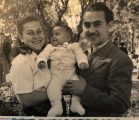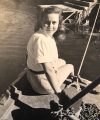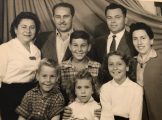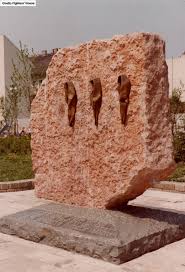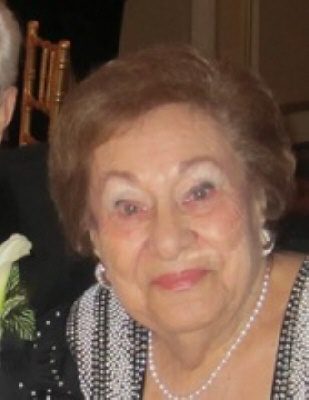- Local Survivor registry
- NAOMI (ETTA) NIEDERMAN
- Local Survivor registry
- NAOMI (ETTA) NIEDERMAN
Survivor Profile
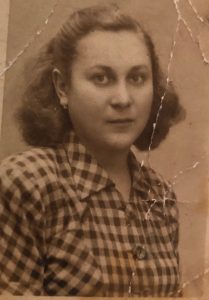
NAOMI
(ETTA)
NIEDERMAN
(1927-2021)
PRE-WAR NAME:
ETTA LEFKOVITS
ETTA LEFKOVITS
PLACE OF BIRTH:
VELKAIDA, CZECHOSLOVAKIA
VELKAIDA, CZECHOSLOVAKIA
DATE OF BIRTH:
FEBRUARY 23, 1927
FEBRUARY 23, 1927
LOCATION(s) BEFORE THE WAR:
VYSOKA NAD UHOM
VYSOKA NAD UHOM
LOCATION(s) DURING THE WAR:
UNGVAR, HUNGARY; BUDAPEST, HUNGARY; RICE CAMP, HUNGARY
UNGVAR, HUNGARY; BUDAPEST, HUNGARY; RICE CAMP, HUNGARY
STATUS:
CHILD SURVIVOR
CHILD SURVIVOR
RELATED PERSON(S):
ASHER NIEDERMAN - Spouse,
ARIE NIEDERMAN - Son,
JAIME NIEDERMAN GOLD - Granddaughter,
ERIC NIEDERMAN - Grandson,
MEIR NIEDERMAN - Son (Deceased),
BRYAN NIEDERMAN - Grandson,
BRETT NIEDERMAN - Grandson,
ASHER NIEDERMAN Great- - Grandson,
AVERY GOLD Great- - Grandson,
ELI GOLD Great- - Grandson
-
SURVIVOR BIOGRAPHY BY nancy gorrell
Naomi (Etta) Lefkovits was born February 23, 1927 in Velkaida, Czechoslovakia. She grew up in Vysoka Nad Uhom, a small neighboring town. Her father, Markus, owned a little grocery store while her mother, Regina stayed at home with all six of the children. Naomi was the second oldest of her three brothers and two sisters. Her grandparents, four uncles and four aunts lived close by. The tight knit family spoke Slovak, kept kosher and celebrated the holidays in each other’s homes—there was no synagogue in the town with few Jews, “maybe a total of 15 families” according to Naomi in her interview. She “loved” school and completed schooling through fifth grade. In 1942 Jewish children were no longer permitted to go to school. “That was very painful to me. My schooling ended then.”
In her interview, Naomi testifies to the persecution starting when the Germans took control of Czechoslovakia. “The Germans and the local police working under them rounded up all the Jewish girls under 18 and took them to the camps. I was forced to leave my home at the age of 14.” Naomi was hidden by non-Jewish neighbors for a couple of days, and then she was taken by a man who was paid to help her cross the border to be hidden by her uncle Jeno Lefkovits in Ungvar, Hungary. Naomi was in hiding for three months with her uncle, aunt and cousin until a neighbor informed the authorities of her presence. Then in the fall of 1942, the Hungarian police came and arrested her and took her by train to jail in Ungvar. To this day, she doesn’t know what happened to her uncle. In her interview, she comments: “I think my aunt and cousin went to Auschwitz.” After several months as a foreign Jew in jail in Ungvar, Naomi was transferred to a brutal jail in Budapest.
Naomi describes her treatment in vivid detail. “I was in a cell with more people than it could hold and was deprived of food and sleep. Day after day the guards took me for interrogation. I did not speak Hungarian. I could not understand the guard’s questions. This made the guards angry and I was tortured in every way during those interrogations. The guards beat me repeatedly. The blood flowed everywhere. The beatings became more frequent and severe but what could I know at 14 except that I was powerless and hated, denied any modesty, privacy or shred of humanity. It was a hopeless situation.”
Furthermore, Naomi testifies that the guards told her that the Germans took her families’ store and all their possessions and deported her father, mother, brothers and sister and grandparents. “With my family gone, who would know I ever existed? That I was abused as less than human? Today I know so many Jews suffered but in that jail in Ungvar, beaten and worse, I was also so totally alone.”
Later in 1943 (she doesn’t know the exact date), Naomi was transferred to the notorious Margit Korut prison in Budapest. The treatment and conditions in Margit Korut prison were far more brutal. Naomi testifies: “We were not allowed to bathe. We were infested with lice, living in filth all the time. We were given so little to eat, I was sure I would starve to death. The guards followed the same procedure as the other prison. I was taken for interrogation and the beatings always followed. At Margit Korut, the guards did not just question, they seemed to want me dead. When I could feel, I thought of finding my parent’s graves. Before long, interrogation time would start again and the beatings would block out my thoughts.”
Sometime later in 1943 Naomi was transferred from Margit Korut in Budapest to the international work camp at Riche, near Shotoro-Ujkel, Hungary. At the international camp for foreigners run by the Hungarian government, all the inmates were Jewish. Naomi reports the conditions at the camp were better than the prisons. Men and woman and little children and mothers were separated. Naomi worked in the fields from sunrise until it was too dark to work. At night the quarters were so cramped there was no place to lie down. The camp guards watched everyone closely, but Naomi was not singled out for interrogation or beatings. She was at the work camp for nearly one year.
In 1944 children under the age of 18 in the camp were transferred. Naomi was placed in a girls’ Jewish orphanage in Budapest. The conditions in the Jewish orphanage were “good” according to Naomi, and she and “all the girls” were “treated well.” Later in 1944, the Germans soldiers took over the orphanage building. Naomi was moved to the Red Cross station in Budapest in late spring. The Red Cross brought sick people there but also “hid” Jewish children by allowing them to work. Naomi helped in the kitchen bringing flour or sugar for cooking. “I was the only one that had the key. I was also stealing some food and putting it in my pants to take it to the other girls in hiding.” One day Naomi was going back to the Red Cross when she was stopped by Germans for papers. “She’s not Jewish, let her go,” they said. She was blonde and had blue eyes. They didn’t think she was Jewish.
Naomi spent her last months of 1944 to liberation working intermittently at the Red Cross hospital and hiding in various safe houses. When the Russians came January 18, 1945, Naomi was still working at times at the Red Cross hospital. She recalls that “they went from house to house; they needed women and they came to us and they wanted me. I ran away and went to another room where these people had died. It was a morgue. This Russian soldier was running after me and I was hiding under a dead man. I escaped. I was free. From this time, I was free.”
Two days after liberation, Naomi went with the other girls to look for water, and there she met for the first time her future husband, Asher Niederman. She was with a friend and she knew he was a Jewish man. Two days later, they met again on a chance encounter at the Zionist organization. From then on, Naomi stayed with the Zionist organization. She didn’t see Asher again until a month later when he returned from work for the organization. Then the two began to travel together with the organization. “We were free so we were happy and not worried. We were with Jewish friends.”
After liberation, it took Naomi and Asher one year of travel to get to Palestine starting in March 1945 from Romania (English zone), to Austria, through Italy, from one DP camp to another (Refer to Asher Niederman’s registry for the full account of the journey). They finally boarded the Ancisereny, the last ship according to Asher not required by the British to port in Cyprus before arriving in Palentine. The voyage took two weeks, and after staying at Atleet, a British detention camp in Israel, Naomi and Asher arrived at Kibbutz Ma’agen on the Kinnert where they married on February 22, 1946.
On the kibbutz, Naomi worked in the kitchen and sometimes in the fields picking tomatoes. She describes having her first child in Israel as “beautiful” but “hard—hard to get things like diapers. But we managed.” Naomi and Asher’s two sons, Ari and Meir were born in Israel. When asked if she ever wanted to return to her family home, Naomi replied, “no.” As for the fate of her family, only her oldest brother, Israel, survived. Naomi was in Israel for two years before she learned that he was alive. Her brother settled in Israel and living there today. The rest of her family perished in the Holocaust.
In 1959 Naomi and Asher emigrated to America seeking better work opportunities for Asher. The family settled in Springfield, New Jersey where they reside to the present day. Naomi went to work at a pharmaceutical factory while the children were in school. “I loved it. I was a forelady and had a lot of responsibility. It was good.”
Naomi and Asher have two sons, Ari and Meir, four grandchildren and five great grandchildren.
Editor’s Notes:
Naomi Niederman, 94, passed on Friday, August 20, 2021 in her home after a long illness surrounded by her beloved husband of 75 years, Asher, her son Arie and her loving family. She was predeceased by Meir, son of blessed memory. She leaves behind her son Arie, and daughters in law, Terri and Silvia, and her four grandchildren Jaime, Eric, Bryan, Brett and five great-grandchildren.
Refer to Asher’s Registry for a full account of their liberation together.
Refer to Jaime Gold, granddaughter in Voices of the Descendants.
Refer to Historical Notes below for Margit Korut Prison, Czech history, Hungarian history.
-
SURVIVOR INTERVIEW BY NANCY GORRELL
- Dates: May and June 2019
- Location: Niederman Residence
- Interviews with Naomi Niederman and Arie Niederman, son
- Interviewer: Nancy Gorrell
- INTERVIEW WITH NAOMI NIEDERMAN
-
Q: Describe your family background.
I grew up in Vysoka Nad Uhom, a small town in Czechoslovakia. My father, Markus, owned a little grocery store. My mother, Regina stayed at home with all six of us children. I had 3 brothers and 2 sisters. I was the second oldest. My father had the only grocery store in our town. My grandparents, four uncles and four aunts lived closed by.
Q: What are your memories of your home life growing up in Vysoka? What language did you speak?
We spoke Slovak.
Q: What was your religious life like growing up?
We kept kosher and celebrated the holidays. There was no temple or synagogue in our small town. We went together to neighbor’s homes for synagogue. There were not many Jews in our town. Maybe a total of 15 families.
Q: Describe your schooling and how you felt about it.
I loved school. I went to school up to 5th grade. In 1942 Jewish children were no longer allowed to attend school. That was very painful for me. My schooling ended then.
Q: Did you experience anti-Semitism growing up?
Yes. The persecution started when the Germans took control of Czechoslovakia.
Q: Can you describe what happened to you in 1942?
The Germans and the local police working under them rounded up all the Jewish girls under 18 and took them to the camps. I was forced to leave my home at the age of 14. I was hidden by non-Jewish neighbors for a couple of days, and then I was taken by a man who was paid across the border to my uncle Jeno Lefkovits’ to be hidden in Ungvar, Hungary.
Q: Can you describe that experience?
I was taken across the border by a man who was paid to take me. All night we were walking through the fields just the two of us. I was three months in hiding at my uncle’s in Ungvar, living with his wife and a little girl cousin.
Q: What happened next?
Then in the fall of 1942, the Hungarian police came and took me by train to jail. I don’t know what happened to my uncle. I think my aunt and cousin went to Auschwitz.
Q: Do you know how you were discovered?
I was informed upon by my uncle’s neighbor and taken to jail in Ungvar. I was a foreign Jew in jail. They let me go after several months because I was under 18 but took me to a jail in Budapest, Hungary.
Q: Describe your jail experience in Buda.
I was in a cell with more people than it could hold and was deprived of food and sleep. Day after day the guards took me for interrogation. I did not speak Hungarian. I could not understand the guard’s questions. This made the guards angry and I was tortured in every way during those interrogations. The guards beat me repeatedly. The blood flowed everywhere. The beatings became more frequent and severe but what could I know at 14 except that I was powerless and hated, denied any modesty, privacy or shred of humanity. It was a hopeless situation.
Q: What happened next to you in jail?
Then they told me the Germans took my families’ store and all their possessions and deported my father, mother, brothers and sister and grandparents. With my family gone, who would know I ever existed? That I was abused as less than human? Today I know so many Jews suffered but in that jail in Ungvar, beaten and worse, I was also so totally alone.
Q: How did you get out of jail?
Later in 1943 (I don’t know the exact date), I was transferred to Margit Korut prison in Budapest.
Q: Describe your experience in Margit Korut prison.
The guards in Margit prison were far more brutal. We were not allowed to bathe. We were infested with lice, living in filth all the time. We were given so little to eat, I was sure I would starve to death. The guards followed the same procedure as the other prison. I was taken for interrogation and the beatings always followed. At Margit Korut, the guards did not just question, they seemed to want me dead. When I could feel, I thought of finding my parent’s graves. Before long, interrogation time would start again and the beatings would block out my thoughts.
Q: What happened to you next?
Sometime later I was transferred from Margit Korut in Budapest to the international work camp at Riche, near Shotoro-Ujkel, Hungary. I know it was sometime in 1943.
Q: Describe your international camp experience. What did you do in the camp?At the international camp run by the Hungarian government, all the inmates were Jewish – it was for foreigners. The camp was better than the prisons. They separated men and woman and little children and mothers. I worked in the fields from sunrise until it was too dark to work. At night our quarters were so cramped there was no place to lie down. The camp guards watched us closely, but I was not singled out for interrogation or beatings. I was at the work camp for nearly one year.
:Q: What happened to you after your time in the International camp?Q
In 1944 children under the age of 18 in the camp were transferred. I was placed in a girls’ Jewish orphanage in Budapest.
Q: What was the Jewish Orphanage like for you?
It was good – all girls were there and we were treated well.
Q: What happened next?
Later in 1944, the Germans soldiers took over the orphanage building. I was moved to the Red Cross station in Budapest in May or June – they brought sick people there but it wasn’t a hospital. We were working in the Red Cross station in Budapest hiding there away from the Germans. They knew I was Jewish. I said so. I helped in the kitchen. I brought the flour or sugar for cooking. I was the only one that had the key. I was also stealing some food and putting it in my pants to take it to the other girls in hiding.
Q: How long were you at the Red Cross station?
Not sure but one day I was going back to the Red Cross when I was stopped by Germans for papers. “She’s not Jewish, let her go,” they said. I was blonde and had blue eyes. They didn’t think I was Jewish. And then I was so scared I didn’t go back to there anymore. I took to the safe houses. I did that a few times. That’s where I learned to cook. They were so happy to get something to eat.
Q: Were there many safe houses in Budapest in 1944?
Yes, but I didn’t go to one. I was liberated in Red Cross Station.
Q: What was liberation like for you?
When the Russians came January 18, 1945, I was still working at times at the Red Cross hospital; they went from house to house; they needed women and they came to us and they wanted me. I ran away and went to another room where these people had died. It was a morgue. This Russian soldier was running after me and I was hiding under a dead man. I escaped. I was free. From this time, I was free.
Q: How and when did you meet Asher, your husband?
We didn’t have water anymore, and we had to go to look for water and that’s how I met Asher. Two days after liberation. I went with the other girls to look for water, and I met my husband. It was the first time I saw him. I was with a friend. I knew he was a Jewish man. Two days later, I met him again at the Zionist organization.
Q: You met Asher “two days after liberation?”
Yes. The first time we met was two days after liberation.
Q: Describe what happened next during liberation. Were you always with Asher?
Not at first. I stayed at the organization until he came back about a month later. Then we were together.
Q: Although you were with Asher, describe the period of liberation from your point of view.
We were free so we were happy and not worried. We were with Jewish friends.
Q: Although you travelled with Asher and the Zionist organization, describe the experience of going to Palestine, the Kibbutz living and getting married from your point of view.
We didn’t know anything and had to figure it all out. It took us one year to get to Palestine. Moving from one DP camp to another. We finally took a boat to Palentine (it was a 2 week boat ride). Me and Asher were married on February 22, 1946 in Kibbutz Ma’agen by the Kinneret.
Q: Did any of your family members survive?
Only my brother, Israel, he was the oldest. We were in Israel for two years before we found out. Some girl had met him and he was asking about me, and she was from Israel too and recognized me and told him she knew me.Q: Where is your brother today?
He lives in Israel.
Q: Did you ever go back to visit your home?
I never wanted to go back home.
Q: What work did you do on the Kibbutz and did you like it?
I worked in the kitchen sometimes, in the field picking tomatoes sometimes. I liked it; I was young. The Kibbutz was right neat the Kinneret. We used to walk from the bottom of the steps to the top (Ben-Gurion built beautiful steps).
Q: What was it like having your first child in Israel?
Beautiful. But it was hard to get things like diapers. We managed and got cloth but some things were difficult.
Q: Were you in favor of going to America too?
I had no choice; it was for Asher to work.
Q: What did you do in America when you moved?
When the kids were in school I went to work – at a pharmaceutical factory. I loved it. I was a forelady and had a lot of responsibility. It was good.
Editor’s Note: In addition, refer to Asher Niederman’s testimony on liberation and the post-war period as he and Naomi were travelling together at this time.
-
HISTORICAL NOTES:
Vysoká nad Uhom is a village and municipality in Michalovce District in the Kosice Region of eastern Slovakia today.
Czech History:
Czechosolvakia was created after WWI from the Austro-Hungarian territories of Bohemia, Moravia and Slovakia. The 150,000 Jews of Bohemia and Moravia, largely German speakers, were part of the middle class. Anti-semitism existed, but had not become politicized. The new nation state gave Jews full social and political freedom.
Slovakia, once part of Hungary, was poorer than Bohemia and Moravia, and the 200,000 Jews who lived there were largely excluded from the community. Churches and political parties characterized Jews as the enemy. The assimilated Jews spoke Hungarian but the Orthodox spoke Yiddish, dressed differently and kept themselves apart.
Hitler invaded Czechoslovakia in March 1939 and the Czech resistance produced brutal German retaliation. Most resistance came from Bohemia and Moravia. To gain an ally, Germany declared Slovakia an “independent” state rather than an occupied territory. Slovakia was the first state to agree to deport Jews. The deportation of Jews to Poland began in 1939. Theresienstadt was built in 1941 as a model concentration camp. In Slovakia, the Nazis designated five assembly points for deportation. From Marc to August 1942, 75% of the Jews were deported primarily to Auschwitz. By the war’s end 11%, or 35, 000 Czech Jews survived, with 5000 in hiding and the rest returning from deportation. Soviet troops entered Prague in April 1945.
Note:
Approximately 60,000 of the 95,000 Slovakian Jews were deported and sent to death camps in German-occupied Poland before 1942. Then the Slovak government made a deal with Germany for the Jews to be “delivered” in exchange for needed workers for the Slovak National Socialist war economy. After the Wannsee Conference of 20 January 1942 the Germans agreed with the Slovaks’ proposal and the two parties came to an agreement by which the Slovak Republic had to pay a fixed amount for each Jew deported. In return, Germany promised that the Jews would never return to Slovakia.
Hungarian History:
The Jews of Hungary were fairly well integrated into Hungarian society by the time of the First World War. By the early 20th century, the community had grown to constitute 5% of Hungary’s total population and 23% of the population of the capital, Budapest. Jews became prominent in science, the arts and business. By 1941, over 17% of Budapest’s Jews were Roman Catholic conversos.
Anti-Jewish policies grew more repressive in the interwar period as Hungary’s leaders, who remained committed to regaining the territories lost at the peace agreement (Treaty of Trianon) of 1920, chose to align themselves with the governments of Nazi Germany and Fascist Italy – the international actors most likely to stand behind Hungary’s claims. Starting in 1938, Hungary under Miklós Horthy passed a series of anti-Jewish measures in emulation of Germany’s Nürnberg Laws. The vast majority of 18,000 mostly foreign Jews who were rounded up in Hungary and deported were massacred on August 27–28, 1941 by the German SS (Kamianets-Podilskyi massacre). In the massacres of Újvidék (Novi Sad) and villages nearby, 2,550–2,850 Serbs, 700–1,250 Jews and 60–130 others were murdered by the Hungarian Army and “Csendőrség” Gendarmerie in January 1942.
Following the German occupation of Hungary on March 19, 1944, Jews from the Hungarian provinces outside Budapest and its suburbs were rounded up and the first transports to Auschwitz began in early May 1944 and continued even as Soviet troops approached. During the last years of World War II, they suffered severely, with roughly 420,000 [9] to 600,000 [10] perishing between 1941 and 1945 (the numbers relate to Hungary’s territory in 1941), mainly through deportation to Nazi German-run extermination camps. A Jew living in the Hungarian countryside in March 1944 had a less than 10% chance of surviving the following 12 months. In Budapest, a Jew’s chance of survival of the same 12 months was about 50%.
Margit Korut Prison:
Today there is a monument on Margit Korut (Boulevard) in Budapest, marking the spot where the prison once stood. In this prison, Hannah Szenes, the paratrooper from Mandatory Palestine, was interned, tortured, and executed.
-
Sources and Credits:
Credit:
SSBJCC Interviews May and June 2019 by Nancy Gorrell; Biography by Nancy Gorrell; Digital historic and family photographs and documents donated by Naomi and Asher Niederman and Arie Niederman, son.




